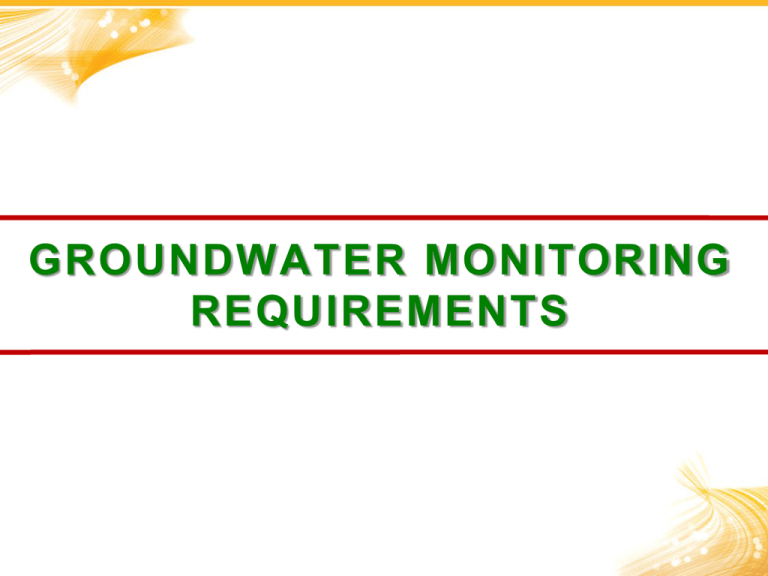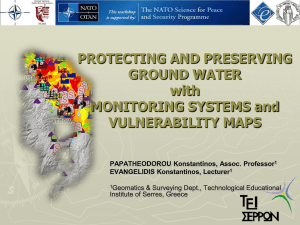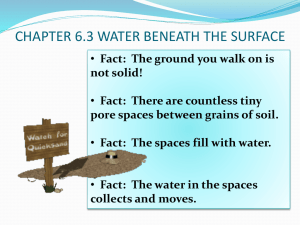Module 9: Groundwater Monitoring 1.4 MB - AGW-Net
advertisement

GROUNDWATER MONITORING REQUIREMENTS Comment on the differences between monitoring for surface and groundwater. Groundwater’s Status Quo Millions of m3 pumped every year: Monitored? Who? How? 100’s of thousands of users: Registered? Controlled? 10’s of thousands of wells/boreholes: Registered? Maintained? Info. about location, abstraction levels, water levels, water quality, formation, etc - 1000’s of sources of pollution: Location, nature & quantity of pollutants? aquifer vulnerability? Many governing departments/institutions: management ? Coordination / cooperation? Joint General Introduction Groundwater is: an extensive, concealed and relatively inaccessible resource. INVISIBLE..! One way to make groundwater visible... by MONITORING it, e.g: Monitoring groundwater level shows a declining water table – which allows water managers to obtain an appreciation of the status of the resource. Year-wise depletion of groundwater One way to make grdwater visible...(contd.) Some Consequences of GW abstraction When pumping is further increased Excessive pumping Normal consequences of any groundwater pumping Groundwater Monitoring Systems by Function SYSTEM BASIC FUNCTION Primary (Reference) Monitoring evaluation of general groundwater behaviour, e.g.: trends resulting from land-use change + climatic variation processes such as recharge, flow and diffuse contamination Secondary (Protection) Monitoring protection against potential impacts to: strategic groundwater resource well-fields/springheads for public WS urban infrastructure from land subsidence archaeological sites against rising WT groundwater-dependent ecosystems early warning of groundwater impacts from: • intensive agricultural land use Tertiary • industrial sites (Pollution containment) • solid waste landfills Monitoring • land reclamation areas • quarries and mines WELL LOCATIONS in areas with uniform hydrogeology and land use. around facilities/areas/ features requiring Protection. immediately down + up-gradient from hazard Types of data for Groundwater Management DATA TYPE Groundwater Occurrence & Aquifer Properties BASELINE DATA (from archives) Supporting Information field stations) grdwater level logs, grdwater monitoring levels, quality, etc. grdwater quality well & aquifer pumping tests monitoring hydrogeologic water Groundwater use TIME-VARIANT DATA (from well pump installations Water use inventories Population registers & forecasts Irrigation energy consumption climatic data land-use inventories geologic maps/sections water well abstraction monitoring (direct/indirect) grdwater level variations riverflow gauging meteorologic observations satellite land-use The Monitoring Cycle Mgt question & monitoring objectives, e.g. trends & changes, impacts & risks, etc. of needs Mgt of info. & actions Define actual info. needed, what for, wherefrom..? etc. static & dynamic water levels, water quality When is groundwater monitoring considered cost-effective? it is driven by a specific objective – monitoring for its own sake often leads to inefficient use of manpower and budgets data collected is: only used for the explicit purpose of the monitoring programme, but Also systematically stored for future use – there are far too many cases of monitoring data being lost along the way. NOT Effectiveness of groundwater monitoring ....is improved by careful attention to: network design system implementation data interpretation data storage from past monitoring activities accessibility of monitoring stations... participatory monitoring amongst water users interpretation and use of data to formulate management actions Measuring GW Use & Aquifer Behaviour Primary goal of aquifer management is to: develop groundwater resources on the basis of a policy plan. monitor & control impacts of abstraction on groundwater systems. Thus, monitoring grdwater abstraction + aquifer water levels provides key information for management of grdwater resources. Measuring GW Use & Aquifer Behaviour (contd.) Monitoring of: grdwater abstraction, and aquifer water levels combined with management actions – reduction of pumping – can contribute to more stable development of groundwater resources. Example: Where historic data reveals over-abstraction.. Establishment of baseline situation: Application of mgt actions, & monitor Monitoring data Is there any dedicated Questions monitoring network in your country, or are existing production boreholes used? Who is responsible for data collection, storage, interpretation and management? Which parameters are monitored, and why this choice? Detecting Groundwater Quality changes Grdwater monitoring requires special sampling procedures as: well pumping sample handling may cause major sample modification through; air entry + degassing + volatile losses NEED for appropriate sampling procedures. Summary of sampling procedures and precautions for specific groups of groundwater quality parameters In designing a monitoring network, what key steps would you take in terms of installation/selection of monitoring wells; data acquisition (who-by, frequency, etc.); data storage and interpretation Early warning potential threats to Aquifer + Groundwater supply quality a critical requirement for detecting any threats to groundwater quality Design of monitoring networks necessary, which... relates to the spatial variation of grdwater flow + quality of more recent recharge.... Early warning of potential threats to Aquifer + Grdwater supply quality (contd.) Detection of groundwater quality trends in aquifer replenishment in vicinity of a public-supply water well Early warning of potential threats to Aquifer Grdwater supply quality (contd.) + Many cities have experienced rapid growth of urban & industrial waste disposal to the ground.... Early warning of potential threats to Aquifer + Grdwater supply quality (contd.) .....thus, necessitating a focused groundwater quality management monitoring, using sampling piezometers. Early warning of potential threats to Aquifer + Grdwater supply quality (contd.) Some objectives of such sampling piezometers: to facilitate early warning of the onset of groundwater pollution........ – to allow timely introduction of necessary control measures. to provide advance warning of the arrival of polluted water at an important groundwater supply source and make provision for treatment or other mitigation. What important natural or anthropogenic water quality problems are in your country? Who carries out the monitoring? Basic rules for a successful groundwater monitoring programme - summary objectives Network Network Design Design must be defined and program adapted accordingly systemand must be understood groundwater objectives must flow be defined program adapted accordingly locations andmust monitoring parameters must be selected sampling groundwater flow system be understood to objectives according sampling locations and monitoring parameters must be selected by objectives appropriately-constructed observation + abstraction appropriately-constructed observation + abstraction wells mustwells be System System implementation implementation must be used used field equipment + laboratory facilities must be appropriate to field equipment + laboratory facilities must be appropriate to the the objectives objectives a complete operational protocol + data handling system must a complete operational protocol + data handling system must be be established established groundwater + surface water monitoring should be integrated groundwater + surface water monitoring should be integrated where where applicable applicable data DataData interpretation interpretation quality be regularly checked through through internal internaland and quality must must be regularly checked external controls external controls makers be with provided withmanagementinterpreted decision decision makers shouldshould be provided interpreted management-relevant datasets relevant datasets shouldbebeperiodically periodically evaluated reviewed program program should evaluated andand reviewed Thank you for your attention








